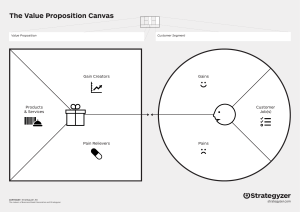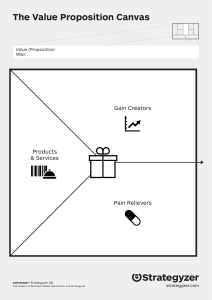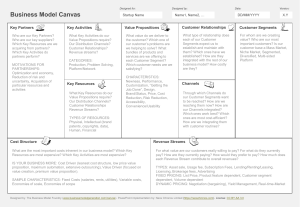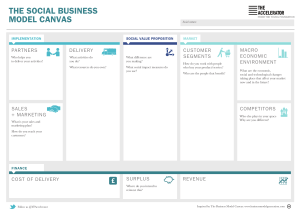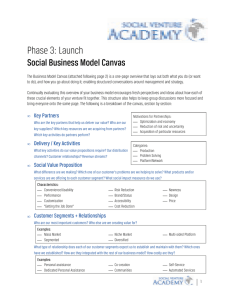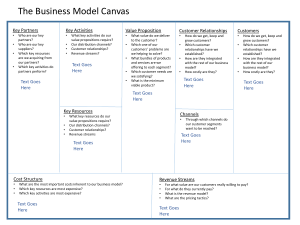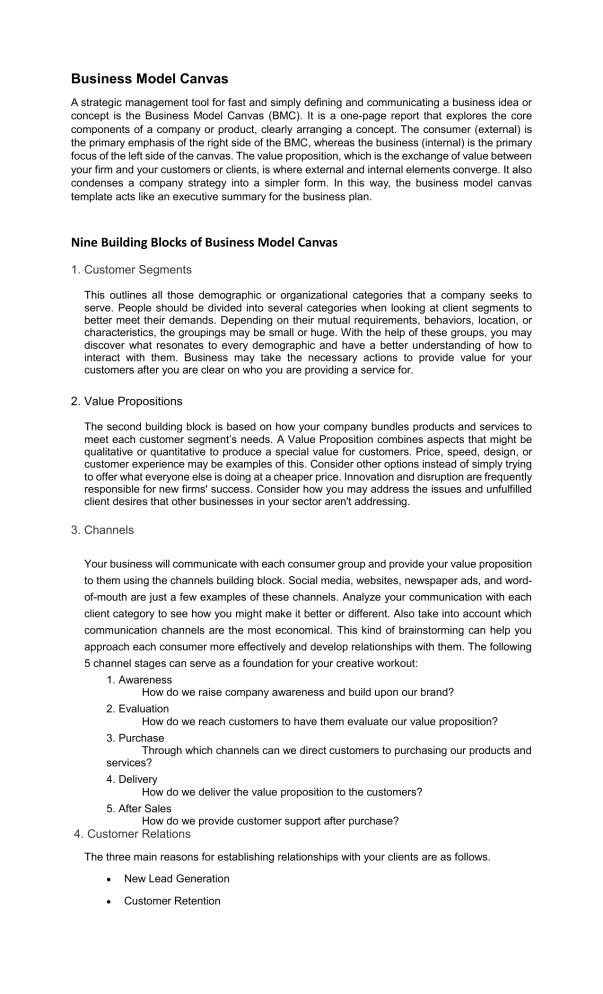
Business Model Canvas A strategic management tool for fast and simply defining and communicating a business idea or concept is the Business Model Canvas (BMC). It is a one-page report that explores the core components of a company or product, clearly arranging a concept. The consumer (external) is the primary emphasis of the right side of the BMC, whereas the business (internal) is the primary focus of the left side of the canvas. The value proposition, which is the exchange of value between your firm and your customers or clients, is where external and internal elements converge. It also condenses a company strategy into a simpler form. In this way, the business model canvas template acts like an executive summary for the business plan. Nine Building Blocks of Business Model Canvas 1. Customer Segments This outlines all those demographic or organizational categories that a company seeks to serve. People should be divided into several categories when looking at client segments to better meet their demands. Depending on their mutual requirements, behaviors, location, or characteristics, the groupings may be small or huge. With the help of these groups, you may discover what resonates to every demographic and have a better understanding of how to interact with them. Business may take the necessary actions to provide value for your customers after you are clear on who you are providing a service for. 2. Value Propositions The second building block is based on how your company bundles products and services to meet each customer segment’s needs. A Value Proposition combines aspects that might be qualitative or quantitative to produce a special value for customers. Price, speed, design, or customer experience may be examples of this. Consider other options instead of simply trying to offer what everyone else is doing at a cheaper price. Innovation and disruption are frequently responsible for new firms' success. Consider how you may address the issues and unfulfilled client desires that other businesses in your sector aren't addressing. 3. Channels Your business will communicate with each consumer group and provide your value proposition to them using the channels building block. Social media, websites, newspaper ads, and wordof-mouth are just a few examples of these channels. Analyze your communication with each client category to see how you might make it better or different. Also take into account which communication channels are the most economical. This kind of brainstorming can help you approach each consumer more effectively and develop relationships with them. The following 5 channel stages can serve as a foundation for your creative workout: 1. Awareness How do we raise company awareness and build upon our brand? 2. Evaluation How do we reach customers to have them evaluate our value proposition? 3. Purchase Through which channels can we direct customers to purchasing our products and services? 4. Delivery How do we deliver the value proposition to the customers? 5. After Sales How do we provide customer support after purchase? 4. Customer Relations The three main reasons for establishing relationships with your clients are as follows. New Lead Generation Customer Retention Upselling Determine which objectives are more crucial to your firm than the others based on these factors. Decide which problems you could encounter with these goals and how to effectively communicate with each goal's client group. 5. Revenue Streams This building block measures the earnings a company generates from each customer segment. When targeting each customer segment, think about what each group is willing to pay. You may create several income streams to use for each of these categories after you learn that different client groups are prepared to pay at various amounts. There are only two sorts of income streams in a company model: • Transaction Revenues - These are the earnings from a single purchase of a good or service by a consumer. • Recurring Revenues - These on-going revenues may include continuous customer service or a long-term value offer. 6. Key Resources Key Resources are the important assets that are available to you and are required to make your business plan a success. With the help of these materials, you may develop your distinctive value proposition, keep vital client connections, expand into new areas, and earn money. These assets may be in the form of material possessions, money, knowledge, or people. 7. Key Activities The essential procedure that a company must engage in for a business model to function is described in its primary building block. These actions, like critical resources, are necessary to uphold client connections, penetrate new markets, develop value propositions, and generate money. Three categories can be used to classify key activities: 1. Production These key activities are the focus of manufacturing firms and relate to the designing, creating, and delivery of products. 2. Problem Solving These activities include knowledge management and training. Problemsolving is key to coming up with new solutions to customer problems. 3. Platform/Network This covers platform marketing, platform administration, and service positioning. This is based on a business that utilizes platforms including networks, software, and well-known brands. 8. Key Partnerships The foundation of important collaborations is the relationships you establish. This might include partners, suppliers, or even companies in your sector that you can form an alliance with. There are 4 main categories of partnerships: 1. Strategic Alliances with Non-competitors 2. Strategic Partnerships with Competitors 3. Joint Ventures to create new Businesses 4. Buyer-Supplier Relationships With these 4 categories of partnerships, we find 3 main motives: 1. Optimization and Economies of Scale This goal is to cut expenses, and it could entail outsourcing or infrastructure sharing. This makes it so your business doesn't have to rely on owning all the resources or handling all the activities independently by optimizing the distribution of resources and activities. 2. Reduction of Risk and Uncertainty This motive is brought on by competitors joining in strategic alliances in one area while remaining competitive in other areas. 3. Acquisition of Resources and Activities It is rare for any business to have access to all the necessary resources and activities to create the most value to their customers. Realizing which assets are more cost-effective to outsource and relying on other companies to provide resources that you could not generate on your own are crucial. 9. Cost Structure The building block for cost structures lists all expenses connected with running a company model. The company will see costs incurred on each of these levels as it determines how to provide value, uphold client connections, and produce revenue. A company's cost structure can be categorized into one of two groups: 1. Cost-driven The goal of this cost structure is to keep expenses as low as feasible. High levels of automation, substantial outsourcing, low-cost Value Propositions, and the smallest feasible cost structure can all be used in this process. 2. Value-driven A company focuses on how to provide the most value for each client group with a value-driven cost structure. A highly customized service and exclusive services are examples of this.
